
Dealers and installers of electronic security systems say 1999 was a repeat of the previous year, and that this year they face challenges most related to the economy, home building and tight labor availability.
On an annual basis, SDM Magazine surveys dealer and installer firms to describe the current year and predict business for the next. This research, the SDM Industry Profile, gauges 1999 performance
Small, Large and Monitoring
Results show that the industry falls into three major categories: several hundred of the largest firms that deal, install and monitor; thousands of small firms that deal, install and sometimes monitor; and a handful of third parties that handle others' accounts for monitoring.The amount of revenue, profit and confidence also match these categories, with the largest firms and third-party monitoring businesses, on the whole, reporting higher figures, while the smallest firms reporting less confidence and greater worry about competitors and profit margins.
To determine total revenue and growth, the SDM Industry Profile employs a consistent formula that accommodates large firm revenues and growth projections without destabilizing the entirety with regard to the vast number of small firms.
Using that formula, the SDM Industry Profile pegs 1999 total revenue through dealers at $16.1 billion, with an adjusted gain over 1998 revenue of 9 percent.
Consistently from 1998 to 2000, about seven in ten dealers feel revenue will go up for the next year. But for the smaller firm, the squeeze on profits and growth of costs, especially labor, marketing and diversity of offerings, have bitten significantly into revenue, knocking down confidence in the future.
It's the Economy, Stupid
No matter the size of product mix of a dealer business, all agree that growth into the next three years depends mostly on the health of the economy both locally and in a general sense. Also top elements for future success: the incidence and reporting of crime and sales and marketing efforts of the dealer firm.New this year in the SDM Industry Forecast, dealers rank residential building activity among the top four reasons for the business' growth. Such concern by security dealers mirrors home builder research that shows some slowing of new home construction that could foreshadow a future stall compared to remarkably strong home construction in 1998 and through the first half 1999. In mid-December, when this SDM Industry Profile was being written, the U.S. Commerce Department reported new housing starts had again slowed in November, thanks in great measure to rising mortgage rates. It was the weakest growth in seven months. The stall has primarily hit single-family home construction, with apartment building and multi-family housing increasing in the same period.
New housing starts are in a "sag" not a bust, according to officials at the National Association of Home Builders (NAHB).
"This is still a very good housing report that shows a high level of new-home production," Charlie Ruma, NAHB president, said when the November 1999 numbers were announced. "The modest decline is right in line with our forecasts for some softening of the market following the exceptionally high pace of starts early this year, and the interest rate increases that have occurred since then are clearly a factor."
Still Strong Pace
Ruma said NAHB is predicting approximately 1.66 million housing starts for 1999 as a whole -- up about 2 percent from last year's very strong pace and the highest level of overall housing production since 1986. A 7.5 percent decline is expected in 2000, bringing starts to what the NAHB says is "a more sustainable and still healthy level of 1.54 million units, as the anticipated effects of higher interest rates and a slowing economy take a toll on the housing sector.Beyond new housing starts, dealers in the SDM Industry Profile listed some daunting challenges they will face over the next three years, with "finding and retaining employees" ranks at the top for the first time.
Also returning to the list of top challenges is the need, say dealers, to control costs. For the small-sized dealer firms, meeting this challenge will improve bottom line profits. For the large firms, it's as much a matter of improving shareholder value, further diversifying the business or as a way to growth the business faster through future mergers and dealer program/account purchases.
Concerning consolidation, a little more than nine percent (9.3 percent) of dealers report they were involved in the purchase of another company in 1999. That's about the same as 1998, and a slow down from the 11 percent rate in 1997 and 1996.
Offshore Competitors Coming
According to one long-time security industry analyst, Jack Mallon, publisher of Security Investing newsletter, this year may see an acceleration of consolidation by firms outside the U.S.Writing in SECURITY Magazine, a Cahners Business Information Security Group publication aimed at corporate security directors, Mallon points to aggressive security companies in Japan, Sweden and Great Britain, among other countries, taking aim at U.S. firms, as the industry evolves globally.
When dealers are asked to name their stiffest competition, most often they name the large, national firms with their mass marketing ability followed by similar-sized local competitors. There's less concern today of encroachment by phone, gas, electric and cable competitors.
Structured wiring in new home construction and delivery of broadband communications to homes, expected to gather speed this year, could transform "also ran" competitors in a real threat. Phone and cable companies, for example, are rolling out Digital Subscriber Line services that could be easily bundled with burglary alarm and approaching multimedia monitoring. And home electrical contractors are exploring low-voltage installation thanks to the builder demand for structured wiring systems.
Dealer Diversification
While utilities and electricians diversify, so are many security dealers. Revenue from burglar alarms still remains the largest part of the business for most dealers; still the percent of revenue from burglar alarms continues downward over the course of four years. This year, for the first time, burglar alarms account for less than half of revenues. So what is growing?In 1999, one area of growth was fire alarms. There was more focused attention to selling home fire alarms in addition to burglar systems.
There was more corporate and commercial growth on the fire side. And there were new offerings, including carbon monoxide detection. Video surveillance continues to be a strong revenue generator, as does electronic door access controls.
On the average, a dealer firm says it's making about six percent of total revenue from home systems, a percentage that remains constant looking backward two years.
When looking at revenue from a service perspective, monitoring fees remain constant 1999 compared to 1998 at about 20 percent of total while revenue from installation dropped from 35 percent of total to 32 percent of total revenues.
Plans to Purchase
The SDM Industry Profile looked into 1999 and year 2000 purchasing plans of dealers.Right at the top: burglar alarms, video surveillance, fire and electronic access controls. For this year, dealers are most bullish on home theater, video surveillance and fire equipment purchases for resale. It is important to note that only about one-quarter of dealers report purchase for resale in the area of home theater, but this minority is very hot on sales this year.
The solid growth of satellite TV systems (and installation by security dealers) as well as impact of DVD equipment, high definition television and digital cable also are converging to make home theater a hot button. When the SDM Industry Profile looks at a dealer's projected next year mix of customers, there's some growth in large commercial clients, as some dealers continue to transform themselves into more sophisticated systems integrators. For the first time, SDM asked about home systems customers, and this new category of customer (at 9 percent) impacted high-end and low-end residential.
When considering typical pricing of residential security systems and monthly monitoring, there's growth under inflation, according to respondents to the SDM Industry Forecast.
Small Price Increases
In 1999, the average "traditional" system sold to a single-family homeowner was priced at $2,000 - only $5 more than the average system in 1998. New this year, SDM also asked about the typical price of a mass marketed system by a large dealer or a firm operating in a dealer program. The price: $612.When it comes to monthly monitoring fee, the average is $27, as reported by the surveyed dealers. That's compared to $24.40 on the average in 1997.
There continues to be a shift when it come to monitoring services from small dealers to large firms, through dealer programs, and to third-party firms that monitor but don't sell or install.
When dealers are asked, they report that the average number of systems monitored by the dealer itself is 3,993 while the average number of systems monitored by another company is 565.
In some respects, dealers, especially those small firms, are running place when looking at new systems as compared to number of customers lost and sold to another firm.
The average number of new security system customers per firm in 1999 totaled 128 residential accounts and 85 nonresidential accounts. At the same time, each firm - on the average - reports it lost 26 accounts to attrition in 1999, while selling on average 102 accounts to another firm during the same period of time.
The SDM Industry Profile
On an annual basis and in mid-October, SDM Magazine mails out a questionnaire to dealers, installers and systems integrators. There was a total of 17.2 percent responses that were usable out of a mailing to 2,000 business units.To determine total revenue and growth, the SDM Industry Profile employs a consistent formula that accommodates large firm revenues and growth projections without destabilizing the entire respondent base with regard to the vast number of small firms. The formula incorporates a count of total business units broken down by segments of total revenue while weighting each segment differently based on current growth and projected growth reported.
The SDM Industry Profile, with breakdowns by type, size and location of the dealer firm, is for sale at $150 per copy. Contact: Karen Hallberg, Research, Cahners Business Information, 1350 East Touhy Avenue, Des Plaines, IL 60018 or email SDM@bnpmedia.comand mention the Year 2000 SDM Industry Profile.
Housing Starts and Stops
For November 1999, the last month prior to writing of this SDM Magazine article, U.S. housing starts fell 2.3 percent to a seasonally adjusted annual rate of 1.6 million units. That's the slowest since last April. The problems are in single-family home construction; apartment building and other multi-unit housing construction rose in November 1999.For all 1999, U.S. housing starts are expected to grow by 2.5 percent to about 1.7 million units. That's a 13-year high. Next year? It's somewhat of a change with many housing analysts predicting growth of home building falling sharply.
"This is still a very good housing report that shows a high level of new home production," says Charlie Ruma, president of the National Association of Home Builders and a home builder from Columbus, Ohio. "The modest decline (in November) is right in line with our forecasts for some softening of the market following the exceptionally high pace of starts early this year, and the interest rate increases that have occurred since then are clearly a factor."
Ruma said the NAHB expects a 7.5 percent decline in 2000, bringing starts to a more sustainable and still healthy level of 1.54 million units, as the anticipated effects of higher interest rates and a slowing economy take a toll on the housing sector.
By mid-December 1999, interest rates on 30-year mortgages have risen about one percentage point since the beginning of 1999, and some additional Federal Reserve Bank tightening early this year is likely to boost the rate to about 8 percent.
"NAHB's most recent survey indicates that builders anticipate some additional slowing of single-family production in coming months, and many builders will take the opportunity to work down backlogs of orders that have built up during the year," says Ruma. He notes that shortages of skilled labor, finished lots and some building materials have caused significant delays in production schedules during 1999.
Starts were mixed across the four U.S. regions in November 1999, with the Northeast and West posting substantial gains of 7.3 percent and 14.9 percent -- to 147,000 units and 417,000 units, respectively -- while the Midwest and South each posted sizable declines, of 6.8 percent to 356,000 units and 9.9 percent to 680,000 units, respectively.
Building permits, which can be an indicator of future building activity, rose 1.3 percent to a 1.61 million-unit rate. This gain reflected a 1.0 percent increase in single-family permits and a nearly 2 percent gain in multifamily permits.
Permits rose in all regions but the South, where a sharp contraction in the multifamily component generated a 4 percent drop in issuance of total building permits.
Corporate Budgets Up
Almost half of the buying security executives at commercial and corporate organizations say their year 2000 budget has increased compared to last year. And their concerns this year have changed: with property crime, employee theft and violent crime now the top three security worries.Annually, SECURITY Magazine surveys security executives to determine current year and next year concerns, practices and buying plans. As part of the SECURITY Profile study, a questionnaire was mailed in October 1999 to 2,500 audited buyers at commercial, corporate and government organizations. SECURITY received a useable return of 22 percent.
Total budget for the average security department in 1999 was $632,000, while average budget for this year is $667,000.
Security directors and managers foresee strong support from their organizations this year. Only 8 percent of respondents to the SECURITY Profile report they face a budget decrease, for example.
There hasn't much change in distribution of budgets within security departments over the past four years. The one exception: more dollars now go to personnel and overhead. Following cost containment and downsizing during the early 1990s, businesses have allowed a build up of in-house resources since 1997. This year, security executives say 42 percent of total budget will go to personnel.
And, when it comes to the types of security threats that businesses face, survey respondents have increased their ranking of violent crime concerns - ranking it third among threats. White collar crime, as a real concern, also has climbed into the top seven concerns.
SECURITY also asked about safety concerns. This year, security directors and managers rank workplace violence as their top concern. Other high ranking safety concerns: natural disasters, arson and government regulation from OSHA to workman's compensation.

CHART 1A
This year is a replay of last year's revenue growth predictions, according to dealer and installer firms surveyed in the annual SDM Magazine Forecast study.
CHART 1B
How long will America's bullish economy continue? Throughout 2000, say security dealers as the strong U.S. economy continues as the top reason for positive bottom line performance.
CHART 1C
A tight labor market, anticipated to continue this year, has knocked off profit as the number one challenge to the typical security business. The need to control costs also reappears after lower ranking in the last two previous annual surveys.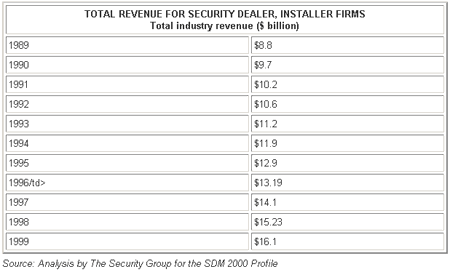
CHART 2
Security dealer, installer and monitoring firms report that solid 1998 growth grew larger in 1999, thanks largely to economic conditions, very strong housing starts, fear of crime and interest by customers.
CHART 3
Consolidation, as measured by those firms saying they have purchased another security-installing company in the past 12 months, has stabilized but at a fairly high percentage. Consolidation seems to have become a way-of-life in the industry.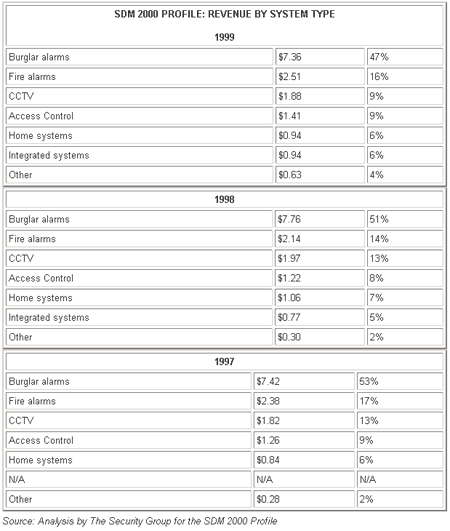
CHART 4
As security dealer and installer firms diversity, the percent of revenue from traditional burglar alarms continues downward. In 1999, there was some growth in fire alarms and other products and services.
CHART 5
While distribution of revenue across types of services remains fairly constant when compared to 1998, there has been some growth in service and maintenance of residential and nonresidential clients.
CHART 6
There continues to be more interest in higher end industrial and commercial clients, often driven by more complex integrated security systems. For those in home systems, there is bullishness when predicted revenues this year.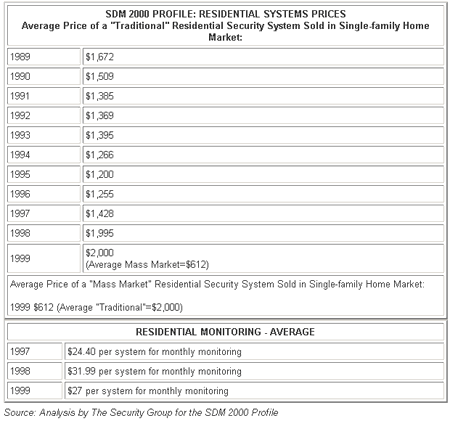
CHART 7
Those dealers selling so-called "traditional" residential systems, as compared to mass market approaches, see pricing rising. A little more than one-third says such systems will cost on average 12 percent more in 2000. For those selling mass market systems, less than 20 percent suggest price increases but and increase of an average of 16 percent.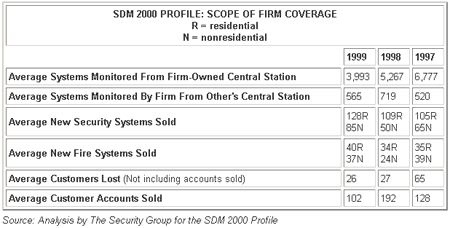
CHART 8
On average, there were more security systems sold by the typical firm this year but monitoring continues to flow to the largest firms and to third party monitoring specialists.
CHART 9
After encroachment by outsiders, the alarm industry now realizes competitive threats come from within the industry.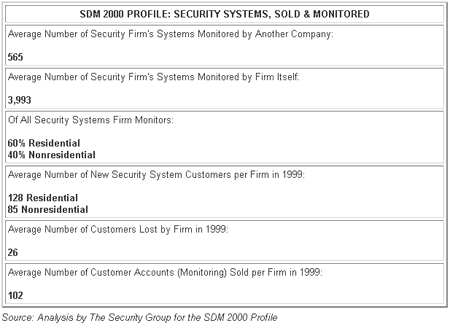
CHART 10
For the average security firm, the sale of the account to a third-party monitoring organization, dealer programs and attrition place significant pressure on the constant need for new security system customers.
CHART 11
There is continued diversification beyond alarms, but the number of other types of systems sold -- for the average firm -- is a fraction of traditional alarms.